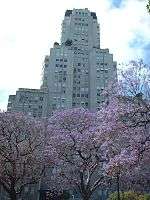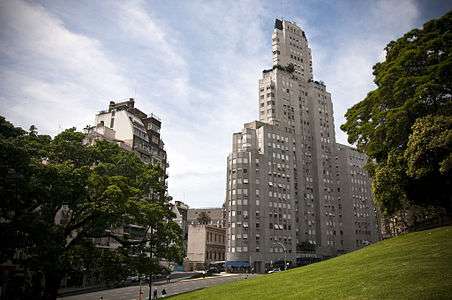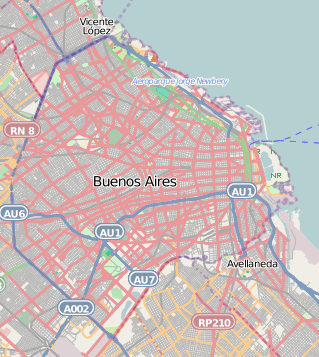Kavanagh building
| Edificio Kavanagh | |
|---|---|
|
| |
| General information | |
| Type | Residential |
| Location |
Florida 1065[1] Retiro, Buenos Aires Argentina |
| Coordinates | 34°35′43.5″S 58°22′28.8″W / 34.595417°S 58.374667°WCoordinates: 34°35′43.5″S 58°22′28.8″W / 34.595417°S 58.374667°W |
| Construction started | 1934 |
| Completed | 1936[2] |
| Opening | 2 January 1936 |
| Height | |
| Top floor | 120 m (390 ft)[3] |
| Technical details | |
| Floor count | 31[3] |
| Floor area | 28,000 m2 (300,000 sq ft), on 2,400 m2 (26,000 sq ft) |
| Lifts/elevators | 12 |
| Design and construction | |
| Architect | Gregorio Sánchez, Ernesto Lagos, and Luis María de la Torre[1][4] |
| Designated | 1999 |
The Kavanagh Building (Spanish: Edificio Kavanagh) is an Art Deco skyscraper in Buenos Aires, located at 1065 Florida Street in the barrio of Retiro, overlooking Plaza San Martín. It was designed in 1934, by local architects Gregorio Sánchez, Ernesto Lagos and Luis María de la Torre, built by the constructor and engineer Rodolfo Cervini, and inaugurated in 1936. Standing at a height of 120 meters, the building is characterised by the austerity of its lines, the lack of external ornamentation, and its large prismatic volumes. It was declared a Historic Civil Engineering Landmark by the American Society of Civil Engineers in 1994[5] and a National Historic Monument by the Argentine government in 1999.[6][7] In the year of its completion the building obtained the Municipal Award for Collective Houses and Facades (Premio Municipal de Casa Colectiva y de Fachada) and three years later its facade received a similar award from the American Institute of Architects.[2]
Its construction took only 14 months and was commissioned in 1934 by Corina Kavanagh, a millionaire of Irish descent who sold two ranches at the age of 39 to erect her own skyscraper.[8][9] The building has a towering form, with symmetrical setbacks and gradual surface reductions. It was created from the outside in, adapting outstandingly comfortable facilities to the space available. The structure was carefully designed to be as slender as possible, in order to avoid unnecessary weight, and influenced by the city planning regulations.[10] The design combines Modernism and Art Deco with a Rationalist approach and is considered the apex of early Modernism in Argentina.
It was at the time the highest skyscraper in Latin America.[9] As the apartments in the new building were aimed at the upper middle classes, no expense was spared in its construction in order to insure a result of the highest quality. All 105 apartments contained the latest in technological advances, including central air conditioning, twelve Otis elevators, and state-of-the-art plumbing. Those on the upper floors have exquisite terrace gardens with views of the river, parks and the city.
Corina Kavanagh lived for many years on the 14th floor in the largest apartment, the only one that occupies an entire floor. There is a legend that says that the shape of the building was designed as a revenge. Corina, who was from a wealthy but not an aristocrat family, fell in love with the son of the Anchorena family, who were both wealthy and aristocratic. The Anchorenas, who lived in a palace on the other side of Plaza San Martín (today known as the San Martín Palace) and had built a church next to the skyscraper, disapproved of the engagement.[11] In revenge, Corina made only one demand to the architects: that the Anchorena family could not view the church they had constructed from their own palace.[1]
The building is separated from the Plaza Hotel by the passage Corina Kavanagh.
Gallery
 Detail of the Art Deco top of the building
Detail of the Art Deco top of the building


.jpg)

.jpg)
References
- 1 2 3 Reina, Laura (3 January 2006). "El Kavanagh y sus 70 años de historias" [The Kavanagh and its 70 years of stories]. La Nación (in Spanish). Buenos Aires. Retrieved 1 December 2013.
El único pedido que les hizo a los arquitectos Gregorio Sánchez, Ernesto Lagos y Luis María De la Torre fue que el edificio, cuya entrada principal se encuentra en Florida 1065, tapara la basílica.
- 1 2 Reina, Laura (3 January 2006). "El Kavanagh y sus 70 años de historias" [The Kavanagh and its 70 years of stories]. La Nación (in Spanish). Buenos Aires. Retrieved 1 December 2013.
El mismo año de su construcción, que terminó en 1936, el Kavanagh obtuvo el Premio Municipal de Casa Colectiva y de Fachada y, en 1939, recibió similar distinción del American Institute of Architects.
- 1 2 Reina, Laura (3 January 2006). "El Kavanagh y sus 70 años de historias" [The Kavanagh and its 70 years of stories]. La Nación (in Spanish). Buenos Aires. Retrieved 1 December 2013.
Con sus 120 metros de altura máxima (posee cinco alas yuxtapuestas, con un total de 31 pisos) superó los 90 metros del Palacio Barolo, su antecedente en cuanto a mayor porte, y fue el primero que contó con aire acondicionado central.
- ↑ "Edificio Kavanagh" [Kavanagh Building]. Comisión Nacional de Museos y de Monumentos y Lugares Históricos (in Spanish). Retrieved 1 December 2013.
Esta obra fue encargada por la Sra. Corina Kavanagh al estudio de los arquitectos Gregorio Sánchez, Ernesto Lagos y Luis María De la Torre, con el requerimiento de que se construyera un edificio para rentas.
- ↑ "Historic Civil Engineering Landmarks Index - Listed by Country". American Society of Civil Engineers. Retrieved 1 December 2013.
Kavanagh Building
- ↑ Fernández, Roxana (23 April 1999). "El Kavanagh, entre los protegidos" [The Kavanagh, among the protected]. Clarín (in Spanish). Buenos Aires. Retrieved 1 December 2013.
Entre ellos están el edificio Kavanagh y el conjunto urbano marplatense integrado por el Hotel Provincial, el Casino, el Torreón del Monje, el muelle de pesca, la Rambla, las recovas y la plaza Colón.
- ↑ "Edificio Kavanagh" [Kavanagh Building]. Comisión Nacional de Museos y de Monumentos y Lugares Históricos (in Spanish). Retrieved 1 December 2013.
Fecha 1999-04-15
- ↑ Reina, Laura (3 January 2006). "El Kavanagh y sus 70 años de historias" [The Kavanagh and its 70 years of stories]. La Nación (in Spanish). Buenos Aires. Retrieved 11 April 2014.
Sólo tuvo que esperar 14 meses para habitarlo, ya que ése fue el tiempo que demoraron los constructores para finalizar el rascacielos, todo un récord para la época.
- 1 2 Novillo, Pablo (30 December 2008). "Venden el piso 14 del edificio Kavanagh: el más caro de la Ciudad" [The 14th floor of the Kavanagh building is up for sale: the most expensive in the city]. Clarín (in Spanish). Buenos Aires. Retrieved 11 April 2014.
El edificio, inaugurado en 1936, fue hecho a pedido de Corina Kavanagh, una millonaria de ascendencia irlandesa que a los 39 años vendió dos estancias y mandó a levantar esta mole de 120 metros de alto que durante años fue rascacielos más alto de Latinoamérica.
- ↑ "Edificio Kavanagh" [Kavanagh Building]. Comisión Nacional de Museos y de Monumentos y Lugares Históricos (in Spanish). Retrieved 1 December 2013.
En virtud de las limitaciones que planteaban las reglamentaciones municipales vigentes, fue necesaria una resolución especial del Concejo Deliberante, tendiente a lograr una altura uniforme de los frentes sobre las calles San Martín y Florida, dentro del volumen calculado. En lograda concepción arquitectónica, el edificio de treinta y tres pisos se fue conformando por escalonamientos sucesivos como consecuencia de las alturas máximas permitidas.
- ↑ Reina, Laura (3 January 2006). "El Kavanagh y sus 70 años de historias" [The Kavanagh and its 70 years of stories]. La Nación (in Spanish). Buenos Aires. Retrieved 1 December 2013.
Contrariada por la oposición de los Anchorena, Corina, algo resentida, quiso ensombrecer una hermosa obra arquitectónica que también hoy deleita a los turistas y transeúntes que pasean por Retiro: la iglesia del Santísimo Sacramento, que los Anchorena habían construido hacia 1920 para utilizarla como sepulcro familiar.
| Wikimedia Commons has media related to Kavanagh building. |

